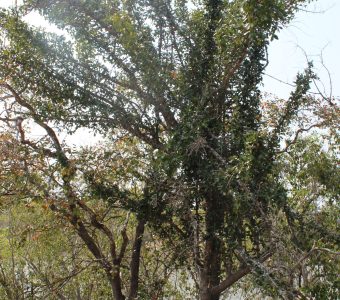



Botanical Name: Garcinia livingstonei
Common Name: Mulyanganga, Kikole, Muchindu, Mukwananga, Mpule, Mukonongo
Plant Family: Clusiaceae (Mangosteen Family)
Growth Form, Habitat and Distribution: An evergreen shrub or tree with glossy leaves and a characteristic spikey growth form with lower branches drooping. Occurs widely across the southern half of Zambia at lower altitudes, but also in the Copperbelt and Northern Provinces. Often in riparian woodland, limestone sinkholes, and on termite mounds in Munga and Mopane woodland.
Size: Height up to 18m, spread 4 to 6m
Bark: Dark grey or brown, becoming darker with vertical fissures. Exudes a thick yellow or red latex if damaged.
Leaves: Simple, opposite, or whorled in threes (4 to 14cm), elliptical, dark green, leathery with a prominent pale midrib and wavy margins, usually on short spurs.
Flowers: Dioecious. Attractive, yellow petals with sickly sweet scent borne in clusters at short branch nodes, July to September.
Fruit: An orange drupe when ripe, 2.5cm, September to November, edible but sweet acidic. Produces up to 5 seeds.
Uses: Fruit eaten by elephants and other wildlife and numerous frugiverous birds. The fruit produces a porridge, or fermented drink. The latex is used as a gum. The bark and roots have medicinal properties. Makes an unusual specimen tree attracting birds but planting should include male and female plants.
